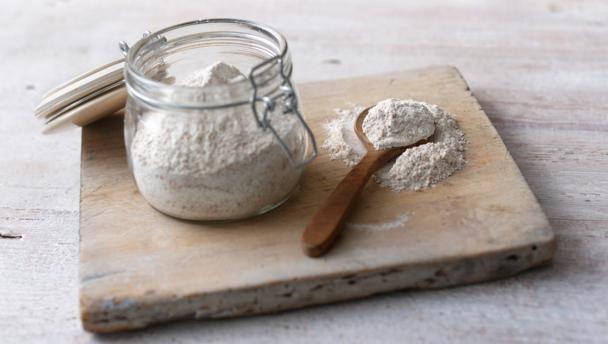

Coarser in texture than white flour, brown wholemeal flour is the finely ground meal of the whole wheat berries. Bran and germ are retained during processing, making wholemeal flour higher in fibre and more nutritious than white flour. It is popular due to increased interest in less refined foods, but many people do not find the end result aesthetically appealing.
 Deep-filled homity pie
Deep-filled homity pie
 Vegetarian nut roast pie with cranberries
Vegetarian nut roast pie with cranberries
 Low-fat beef and bean burrito with lime yoghurt
Low-fat beef and bean burrito with lime yoghurt
 Crab and leek tart
Crab and leek tart
 Irish fish chowder with soda bread
Irish fish chowder with soda bread
 Proper baked beans with soda bread toast
Proper baked beans with soda bread toast
 Red onion tarte tatin
Red onion tarte tatin
 Multi-seed savoury crackers
Multi-seed savoury crackers
 Stuffed paratha for kids
Stuffed paratha for kids
 Baked samosas
Baked samosas
 Baked courgette fritters with marinara sauce
Baked courgette fritters with marinara sauce
 Apple and blackberry crumble
Apple and blackberry crumble
 Banana bran muffins
Banana bran muffins
 Irish soda bread
Irish soda bread
 Courgette and caraway cake
Courgette and caraway cake
 Crackle top bread
Crackle top bread
 Doris Grant loaf
Doris Grant loaf
Some varieties of wholemeal flour contain more bran and germ than others. The label should clearly state how much bran and germ has been retained – wholemeal flour typically contains 81%.
Keep the flour in an airtight container in a cool, dry place.
Combined with fat, liquid, eggs or yeast, wholemeal flour is used in breadmaking, baking, pasta and pastry.
Do not confuse wholemeal flour with wheatmeal flour or brown flour, both of which contain some bran and germ, but are generally paler.
Article by Sejal Sukhadwala
Type the ingredients you want to use, then click Go. For better results you can use quotation marks around phrases (e.g. "chicken breast"). Alternatively you can search by chef, programme, cuisine, diet, or dish (e.g. Lasagne).